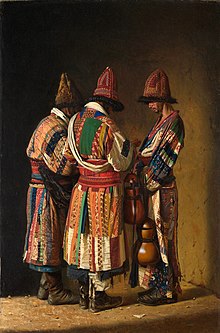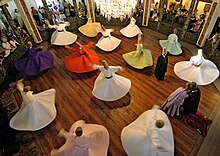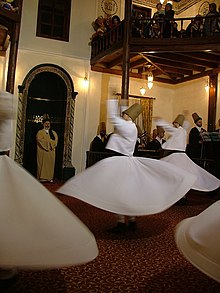Dervish
The term dervish , especially in European languages, denotes a Sufi , a member of a Muslim ascetic- religious order ( tariqa ) , which is generally known for its modesty and discipline.
Dervishes practice Sufism and are considered a source of wisdom , healing, poetry, enlightenment and wisdom. For example, Nasreddin became a legend in the Orient not only for Muslims .
Etymological origin

The name dervish comes from the Persian wordدرویش, DMG darwīš , literally “standing on the doorstep” with the transferred meaning “poor”, “beggar”, “wanderer”, “ecstatic”, which usually means an ascetic monk, and corresponds to the Arabic termفقير, DMG faqīr 'Poor'. The word is z. B. Used in Urdu to express an imperturbable or ascetic phrase, darwaishanathabiyath . This is an attitude that does not value material possessions and the like. A common German translation for darwīsch (also därwīsch ) or dervish is 'beggar'. But it is not necessarily to be understood literally that every dervish is a beggar; but this term also serves as a symbol for the fact that those who are on the path of Sufism recognize their own "poverty compared to God's wealth".
The term dervish itself is derived from the Persian word is , gate ' , door', a symbol that the beggar from door (thresh) moves (thresh) to door. In Sufi symbolism, this also means the threshold between the recognition of the earthly world (material, see also dunya ) and the divine world beyond .
Western authors have often used the term dervish historically inaccurately and associated it with the Mahdi uprising in Sudan and other anti-colonialist uprisings.
Colorfully dressed dervishes in Pakistan and Afghanistan as well as in eastern Iran with and without spiritual descent from a certain order are called Malang . The term can refer to a fakir , a kind of sorcerer / magician or a wandering Sufi monk ( Qalandar ) .
Religious practice
Numerous dervishes take a vow of poverty and live in withdrawn monastic asceticism . Some choose to exist as beggars, others are employed; Egyptian Qadirites - called Kadiri in Turkey - are z. B. Fischer.
As a rule, traditional dervish associations (sufi orders or tariqas ) are directly connected to the prophet Mohammed via a spiritual chain ( silsila ) either via Ali or Abu Bakr . They live according to a monk rule , in a certain sense sometimes comparable with Christian monastic orders, but there are also differences such as the commandment to lead a married life. Various religious orders and their subgroups have emerged and disappeared again over the centuries (since the 12th century).
The ecstatic trance dance (sema) , of the Mevlevi exerted -Orden Turkey, is one of the physical methods in religious ecstasy ( majdhb , fana ) to lapse and come into contact with God (see also dhikr ). The headgear of the Mevlevi dervishes is called Sikke .
Otherwise, the cap, which varies from order to order, is also called taj ('crown'; cf. Taj Mahal ) because the dervish or mystic is his own king (sometimes dervishes also had the title or nickname Shah or King). The different colored strips of Tajj material that converge in the tip of the headgear symbolize the diversity culminating in divine unity. Like the tabarzin and the beggar's bag , the cap is one of the seven symbols of the dervishes.
The Bektashi , which historically close cooperation with the Alevis are linked, also practice unorthodox practices, such as the consumption of alcohol in the ritual meal ( sofra , table '), the salt, bread and even alcohol ( which are served) or services without sexual separation .
The Sanusiya in North Africa , on the other hand, are strictly religious and understand meditation as part of pure Islamic teaching. Other orders and subgroups sing verses of the Koran , drum or dance intensely, according to their respective traditions. Some practice silent meditation (e.g. Naqschbandi ), like most Sufi orders in South Asia , some are influenced by the Chishti order . Each association has its own vestments and special methods of admission and initiation.
The whirling dervishes have become a tourist attraction especially in Turkey, the home of the Mevlevi order from Konya . Today their Sema ceremonies are held for this purpose alone since Mustafa Kemâl Pasha (called Ataturk ), the founder of the Turkish Republic , banned the rituals of the Mevlevi dervishes with Law No. 677. Since 1954, the sema has been allowed to take place again on the occasion of the anniversary of Rumi's death on December 17th, but not in the motherhouse of the Tariqa, but in a sports hall.
Well-known Persian dervishes (of the later Niʿmatullāhī order ) in the 18th century were Maʿsum Ali Shah, who came to Shiraz from southern India, and his student Nur ahAli Schah (* 1760 in Isfahan; † 1797) and his friend, the Setar player Muschtaq. Nur ʿAli Shah's wife, the Diwan poet Hayati, was also a dervish.
See also
literature
- Reshad Feild : The Final Barrier - I went the way of the dervish . Diederichs, Düsseldorf 1977; Chalice, Xanten 2014, ISBN 978-3-942914-11-6
- Jürgen Wasim Frembgen : Dervishes. Lived Sufism. Wandering mystics and ascetics in the Islamic Orient. DuMont, Cologne 1993.
- Pir Vilayat Inayat Khan : The call of the dervish. Synthesis-Verlag, Essen 1996, ISBN 3-922026-07-9 .
- Jens Peter Laut: "Dervish": A daring word explanation. In: Thomas Jürgasch et al. (Ed.): Presence of unity. On the concept of religion. Festschrift on the occasion of Bernhard Uhde's 60th birthday . Rombach, Freiburg (Breisgau) et al. 2008, ISBN 978-3-7930-9550-7 , pp. 301-311.
- Gerhard Schweizer : The dervishes. Saints and heretics of Islam. 2nd Edition. Verlag Das Bergland-Buch, Salzburg 1984, ISBN 3-7023-0111-9 .
- Idries Shah : The Sufis. Message of the dervishes, wisdom of the magicians. Hugendubel, Kreuzlingen et al. 2006, ISBN 3-7205-2849-9 .
- Muhyiddin Shakoor: Written on flowing water. My career as a dervish. The experience report of a western seeker on the Sufi training path. Barth, Bern et al. 1991, ISBN 3-502-67561-9 .
- Peter Lamborn Wilson , Karl Schlamminger: Weaver of Tales. Persian Picture Rugs / Persian tapestries. Linked myths. Callwey, Munich 1980, ISBN 3-7667-0532-6 , pp. 14-29 ( The Dervishes ).
Web links
Individual evidence
- ↑ The Hakim of Nischapur Omar Chajjám and his Rubaijat , based on old and recent Persian manuscript finds by Manuel Sommer, Pressler, Wiesbaden 1974, p. 134
- ↑ See also: Nader Ardan, Laleh Bakhtiar : The Sense of Unity. The Sufi Tradition in Persian Architecture. ABC International Group.
- ^ Peter Lamborn Wilson, Karl Schlamminger: Weaver of Tales. Persian Picture Rugs / Persian tapestries. Linked myths. Callwey, Munich 1980, ISBN 3-7667-0532-6 , pp. 14 and 18 f.
- ^ Mark Soileau: Spreading the Sofra: Sharing and Partaking in the Bektashi Ritual Meal. In: History of Religions, Vol. 52, No. 1, August 2012, pp. 1–30, here p. 16
- ↑ Act No. 677 of November 30, 1925 on the prohibition and closure of the orders of dervishes, monasteries and mausoleums, on the prohibition of the profession of mausoleums guardian and the management and award of certain titles, RG No. 243 of December 13, 1925.
- ^ Divan-i Hayati .
- ^ Peter Lamborn Wilson, Karl Schlamminger: Weaver of Tales. Persian Picture Rugs / Persian tapestries. Linked myths. 1980, pp. 14-17 and 20-25.



